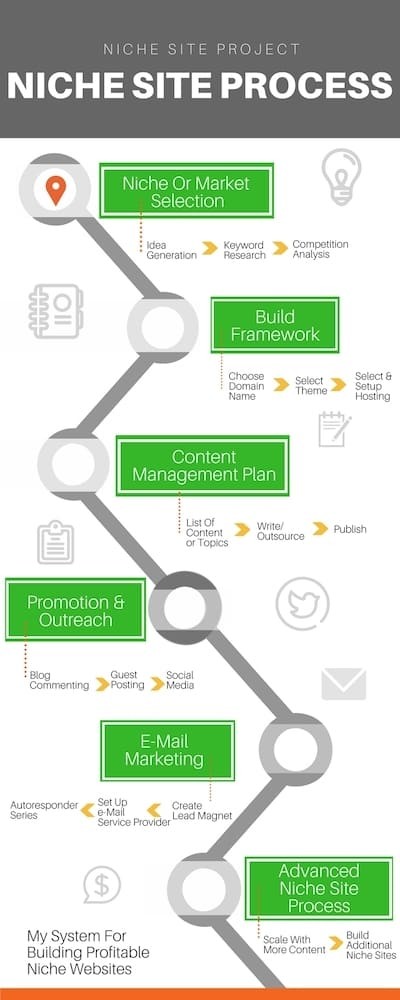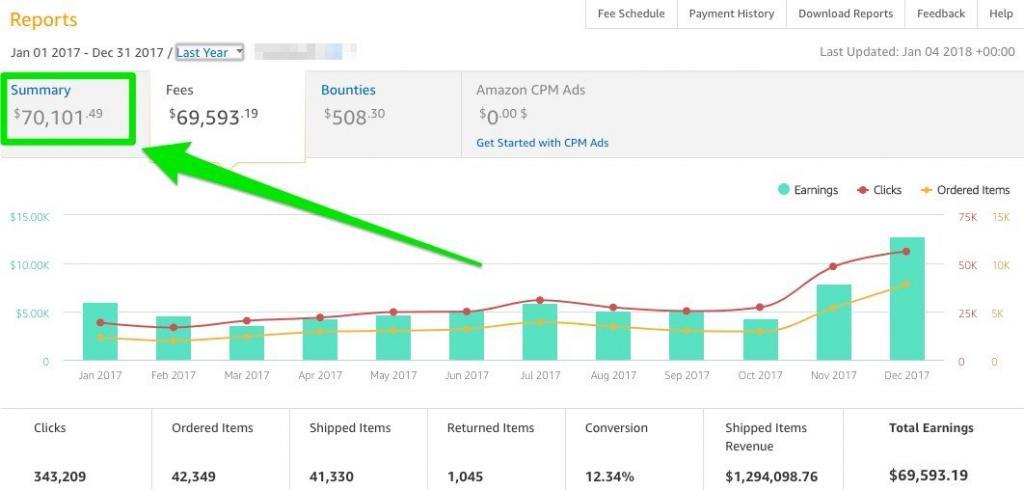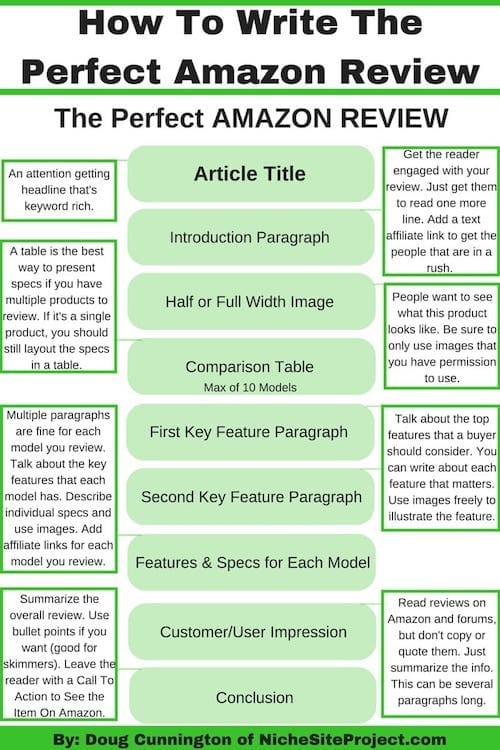
Here is the full roadmap. This is the Definitive Guide to Create Successful Amazon Niche Sites and it was created with project management in mind.
[updated Oct 17, 2022] This is the framework that you’ve been looking for…
This resource is for people that are new to Niche Site Project – and even for the long-time niche authority site owners that want to learn more.
This page serves as an informational hub for all things related to Amazon Affiliate Marketing with a sprinkle of project management.
You’ll learn about display ads, too— so you can earn money from diverse sources, not just Amazon Associates.
I’ll tell you about:
- Affiliate Marketing and Niche Sites
- The Amazon Associate Program
- The Value of Display Ads
- The high-level process and Roadmap
- Examples of real affiliate niche sites
Then, I’ll point you to deeper explanations of the process and the roadmap. This page is like an intro and table of contents for the process of creating an Amazon Affiliate Site.
Get all my personal templates & systems for niche sites.
Niche Site vs Authority Site
If you’ve heard about authority sites, niche sites are basically the same thing. Both niche or authority websites publish content, get traffic from Google organic search, and have product reviews and informational, how-to content.
They earn from affiliate commissions, display ads, and digital products. They can be very large sites with dozens, hundreds, or thousands of pieces of content. Both can have YouTube channels, social media, and email lists.
It just comes down to semantics.
Intro Affiliate Marketing
Here is how affiliate marketing works:
You get a commission if you recommend a product and someone makes a purchase after using your affiliate link.
The concept is simple, but it may be new to you. I was right there with you — see, I found the Smart Passive Income Podcast in 2013.
I didn’t know a thing about affiliate marketing or anything about making money online.
There are a lot of affiliate programs available to marketers. For example, you can work with a big marketplace like Shareasale or Commission Junction, who helps match up marketers with retail companies.
Lastly, there are programs with big retailers, like Walmart, Target, and Amazon… My favorite is Amazon. Here are a couple of data points if you want to see what typical niche sites look like and what webmasters can potentially earn.
The Amazon Associate Program
I love Amazon. For most things, I prefer to order online versus going to a physical retail location. And maybe that’s why I like the Amazon Associate program so much.
The official name of the affiliate program is called the Amazon Associate Program.
Pros
- People buy a lot of things on Amazon.
- You get a commission for all the products in someone’s order, not just the item that you link to.
- Very high conversion rate due to the low friction ordering process.
- Amazon has an extremely diverse range products.
- You can market the products using a blog, YouTube, or several social media type platforms.
Cons
- Lower commission rate than other programs.
- Many rules to follow in the Operating Agreement.
- You can’t use email marketing directly.
Here is the official page for the Amazon Associate Program.
Here are the latest commission rate percentages.
*There might be affiliate links throughout this guide and on this website. So if you make a purchase, I might earn a commission at no additional cost to you. Many of the links aren’t affiliate links and lead to helpful content.
Display Ads
You’re probably familiar with display ads, even if you don’t know the term. They are the ads on websites, and you’ve probably heard of Google Adsense.
Adsense is the most basic of display ads since it’s been around for a long time, plus it’s historically been the easiest way to integrate.
But other companies popped up to help web publishers earn more. Companies like Ezoic, AdThive, and MediaVine showed up to add efficiency to the process of displaying ads.
One of the main benefits you get with display ad networks is effective a/b testing of ad placement and sizes. Basically, if you use an ad network, they will have software that will test ads to see how you can earn the most while preserving the visitor experience.
- If you don’t use an ad network, then you will have to place ads statically and attempt to run a/b testing.
- If you use an ad network, then the network can dynamically place ads on your site so you’ll be able to optimize the ad placements over time.
I dislike most ads on the sites I visit — and if the ads get in the way of the content, then it’s terrible. So the best way to use display ads is a balance of showing enough ads to earn some money and not showing too many ads, so visitors have a bad experience.
The worst offenders are recipe sites that have display ads pop up, along with multiple auto-play videos. This usually happens when I’m on my small cell phone screen. The result is a small square of the visible screen of what seems to be a resolution of 38 x 69.
What about Ads with Affiliate Content?
I used to caution people about using display ads on pages where the goal is to earn from affiliate commissions, usually a product review-type post. But after years and dozens of data points, it’s pretty rare to hear from someone that has an affiliate site that has a drop in earns due to display ads.
In fact, I can’t think of one story where someone has lost money because they added display ads.
Display Ads Are Best With Informational Content
Niche sites should have a blend of product reviews along with informational content. Informational content is usually “how-to,” instructional, or informative in some way.
This is opposed to product review content, where the goal is to help someone learn about a product or product(s), so they’ll go and buy something.
Niche sites get most of their traffic from Google, and Google likes for sites to have informational content. In fact, Google has been releasing algorithm updates that target sites that have low-quality product reviews in the last couple of years.
So it’s great to have 50% or more informational content on your site. That’s normally straightforward since there are usually more informational keywords in a niche than product review keywords. We’ll get more into keywords soon…
You can also place affiliate links in your informational content. If you can help someone do something faster, better, or cheaper using a product, then you should tell them about it and link to it. So I really look at the keyword phrase and title to guide me whether a given post is targeting an informational versus product review keyword.
This is the Definitive Guide to Create Successful Amazon Niche Sites
This guide is a roadmap that will help you navigate your way to creating a profitable Niche Site. (See Amazon Affiliate website examples here to get in the mood…)
There is a huge amount of information out there about niche sites. A lot of it is really old and out of date. This page is up to date, and I take the time to make changes as time goes on and things change.
It’s different from other guides because I use Project Management Best Practices to continuously improve the process. I’m a certified Project Management Professional — by the Project Management Institute.
I’ve been a PMP since 2008, and let me tell you a couple of things about my experience.
- I worked as a management consultant for a few years.
- I found my way into project management after working on testing, development, requirements, etc… teams.
- I’m process and system-oriented.
I use templates and make things repeatable. I realized systems and templates and repeatability was missing most of the material on niche authority sites.
It seems like most online marketers don’t start in information technology (IT), but a lot of IT people like the idea of online marketing.
This page is here to help you locate the resources you need to master this niche site stuff.
How to Build an Amazon Affiliate Website: Niche Site Process
This is the same process that I used to create my niche sites. I studied Pat Flynn (Smart Passive Income) and Spencer Haws (Niche Pursuits) when I started in mid 2013.
As a reference point, this is the process I used to create a site that made over $31,000 in 2016.

Then over $70,000 in 2017.

Also, I sold a site in 2017 for $235,000. (I covered selling the site on my blog series called Project Go White Hat.)
Wonder how much Amazon Affiliates can make?
I’m only mentioning these data points to add credibility to my process. I didn’t just make up a roadmap for the process — I tested it extensively and students and readers have also.
Check out some success stories on YouTube. (opens in YouTube)
When I started learning about niche sites, there were some so-called experts that really weren’t practitioners. They were just well studied people who started blogs and didn’t really know what they were talking about. So I accepted some advice from people didn’t know what they were doing and most likely just wanted to pitch software and tools to make affiliate commissions. It was like getting directions from an out of towner.
I knew that Pat Flynn and Spencer Haws were experts and practitioners of affiliate marketing. So I studied their processes, implemented them, and put my own spin on the whole thing using my project management expertise.
It’s the same process that countless other niche site owners have used, too.
The process works for a niche site on two-way radios or puppy collars or blenders and anything in between.
The process works because it follows a precise set of phases that you execute in a specific order.
I removed ineffective steps or if there is no ROI or a low ROI for a task, then we don’t do it. Learn the Steps of the Niche Site Process for Amazon Affiliate Websites. The following roadmap outlines the Niche Site Process, or NSP for short.

Print out the roadmap and study it. Post it next to your desk. If you plan on building out a niche website then you’ll reference the NSP often.
When you learn new concepts and tactics, like keyword research & outsourcing, you’ll need to remind yourself where you are in the NSP.
Otherwise, you could be wasting money and, more importantly, wasting your time.
A word of caution: There isn’t much value in understanding how to do keyword (KW) research and competition analysis alone.
There is enormous value (and profit) in understanding how to use these niche selection strategies within the overall Niche Site Process.
That applies to anything in the NSP – You must understand where a step fits within the process, not just how to do it.
To keep the topic focused, we’re mainly considering niche site monetized using the Amazon Associate, the affiliate program for Amazon.
Here are the steps:
- Select a Niche or Market
- Build Out the Framework
- Develop a Content Management Plan
- Plan Your Niche Site SEO
- Execute an Outreach & Promotion Campaign
- Execute an Email Marketing Campaign (if desired)
- Continue Growing the Niche Site (if desired)
Some of the steps may be totally new to you. Don’t worry!
Let’s review each one of the steps right here on this page. Then, I will point out resources that are available to learn more. You’re going to be an expert compared to 99% of the people out there.
Some of the resources are freely available on the Niche Site Project blog. Other resources are for sale in training courses.
That’s right…I sell some stuff. And, there are affiliate links on this page, and at no additional cost to you, I will earn a commission if you decide to make a purchase.
Dig into this Niche Site Process page.
Review it carefully and pay close attention…
I will reveal the exact system that I use to create profitable Amazon Affiliate websites.
Let’s start at the beginning: Selecting a Niche and Keyword Research…
If you’d rather have a summary explained to you, check out this video that covers this page at a high level.
Navigation
Get all my personal templates & systems for niche sites.
- Select a Niche or Market
- Build Out the Framework
- Develop a Content Management Plan
- Plan Your Niche Site SEO
- Execute an Outreach & Promotion Campaign
- Execute an Email Marketing Campaign (if desired)
- Continue Growing the Niche Site (if desired)
- Frequently Asked Questions about Niche Sites
- Aged Site Case Study: Done-For-You, Ready Made Site [in progress]
BONUS: The Perfect Amazon Affiliate Review
The graphic below shows you just how to write the perfect Amazon Product review your niche website.
 (See Large Version Here)
(See Large Version Here)
Get all my personal templates & systems for niche sites.
Thanks & References
Here are some other great resources for Amazon Niche Sites:
- Link to the Amazon Associate Program
- Here is the guide by Spencer Haws at Niche Pursuits. I pretty much learned by watching his case studies and studied them. It’s one of the most comprehensive guides out there.
- My buddy, Jon Haver of Authority Website Income, wrote this post called, How to Setup Amazon Affiliate Websites on WordPress. It focuses on the tools that he uses and how he sets up pages and sites. He also has a guide here about things that will get your site banned by Amazon, complete with a checklist.
- Wonder about the Value of an Amazon Affiliate Site?
- Amazon affiliate sites can be sold for 30 to 40 times monthly average profits. The monthly average profit calculation is done over a 6-month period usually, or a 12-month period if it’s a seasonal website.
- There is strong demand for sites monetized by Amazon since they are easy to maintain, have easy wins for growth, and can be diversified with other revenue streams. For a more detailed write-up of how to buy Amazon affiliate sites, read this guide.
Comments on this entry are closed.
Monster guide Doug – this is the kind of stuff I wish I had available when I first started out all those years ago! It would have saved me a lot of wasted time and money spent on crappy WSO courses!
Great job, it would be great if you were to keep this updated to the latest goings on in SEO and niche site building, that way it would remain relevant not matter when someone reads it.
Thanks, @cloudincome:disqus. I will be trying to keep it up to date – definitely.
If you have any resources at Cloud Income that would be relevant, let me know and I’ll link it up.
Wow Doug talk about giving away the state secrets!
Wow one of the best articles I have read in a while. I have a couple projects I am finishing up… but then I’m diving head on into this 🙂
This is a strong guide. I Sumo what you are using here? or is that hello bar that pops up on the top the post? Ive been using mail chimp, and have above 5 subscriber from a small niche site- no lead magnet, just a subscription box on the top right corner- I have send anything to them lol- I honestly didn’t expect subscribers yet- So i cant do the auto series and don’t think its worth the investment yet- the site has small earning at this point. Any ideas? pointers?
Hey RJ – thanks! It took a little while to put it all together.
The bar at the top is sumome – It is pretty good overall.
I would hold off for now on the auto responder part…how much traffic do you get at that site?
Hey Doug,
It gets a few thousand impressions and a few hundred clicks per month according to webmaster- its been about 9 months and made its 1st amazon sale at the end of Nov. 2014 (6 months in).
P.S. I just reread my comment, its suppose to say “… I haven’t sent anything to them”
Hi, I found this to very useful and starting to make niche sites again.
I do have one question though about domain names.
I think I read before that using brand new domain names takes a minimum of 6 months for keywords to start showing on google? Is this true?
I wouldn’t mind 2-3 months but 6 months is a bit too long.
What is your experience with brand new domain names?
Hey, thanks for the comment.
KWs will show up sooner but it can take 6 months to get significant traffic for a specific KW. You can make the situation better by working on lower volume KWs and long tails.
Yep, 6 months is a long time!
This is an incredible guide. Thanks for sharing your process!